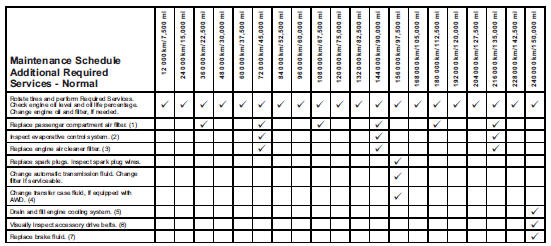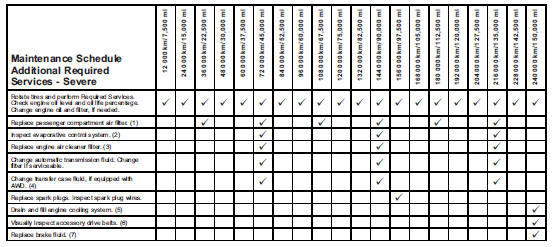Chevrolet Captiva Owners Manual: Maintenance Schedule

Owner Checks and Services
At Each Fuel Stop
- Check the engine oil level. See Engine Oil on page 10-8.
Once a Month
- Check the tire inflation pressures. See Tire Pressure on page 10-44.
- Inspect the tires for wear. See Tire Inspection on page 10-50.
- Check the windshield washer fluid level. See Washer Fluid on page 10-20.
Engine Oil Change
When the CHANGE ENGINE OIL SOON message displays, have the engine oil and filter changed within the next 1 000 km/600 mi. When the CHANGE ENGINE OIL NOW message displays, have the engine oil and filter changed as soon as possible. If driven under the best conditions, the engine oil life system might not indicate the need for vehicle service for more than a year.
The engine oil and filter must be changed at least once a year and the oil life system must be reset.
Your trained dealer technician can perform this work. If the engine oil life system is reset accidentally, service the vehicle within 5 000 km/ 3,000 mi since the last service.
Reset the oil life system when the oil is changed. See Engine Oil Life System on page 10-10.
Tire Rotation and Required Services Every 12 000 km/ 7,500 mi
Rotate the tires, if recommended for the vehicle, and perform the following services. See Tire Rotation on page 10-50.
- Check engine oil level and oil life percentage. If needed, change engine oil and filter, and reset oil life system. See Engine Oil on page 10-8 and Engine Oil Life System on page 10-10.
- Check engine coolant level. See Engine Coolant on page 10-14.
- Check windshield washer fluid level. See Washer Fluid on page 10-20.
- Visually inspect windshield wiper blades for wear, cracking, or contamination. See Exterior Care on page 10-74. Replace worn or damaged wiper blades.
See Wiper Blade Replacement on page 10-25.
- Check tire inflation pressures.
See Tire Pressure on page 10-44.
- Inspect tire wear. See Tire Inspection on page 10-50.
- Visually check for fluid leaks.
- Inspect engine air cleaner filter.
See Engine Air Cleaner/Filter on page 10-12.
- Inspect brake system.
- Visually inspect steering, suspension, and chassis components for damaged, loose, or missing parts or signs of wear. See Exterior Care on page 10-74.
- Check restraint system components. See Safety System Check on page 3-16.
- Visually inspect fuel system for damage or leaks.
- Visually inspect exhaust system and nearby heat shields for loose or damaged parts.
- Lubricate body components. See Exterior Care on page 10-74.
- Check starter switch. See Starter Switch Check on page 10-24.
- Check automatic transmission shift lock control function. See Automatic Transmission Shift Lock Control Function Check on page 10-24.
- Check ignition transmission lock.
See Ignition Transmission Lock Check on page 10-25.
- Check parking brake and automatic transmission park mechanism. See Park Brake and P (Park) Mechanism Check on page 10-25.
- Check accelerator pedal for damage, high effort, or binding.
Replace if needed.
- Visually inspect gas strut for signs of wear, cracks, or other damage. Check the hold open ability of the strut. See your dealer if service is required.
- Inspect sunroof track and seal, if equipped. See Sunroof on page 2-14.

Footnotes — Maintenance Schedule Additional Required Services - Normal
- Or every two years, whichever comes first. More frequent replacement may be needed if the vehicle is driven in areas with heavy traffic, areas with poor air quality, or areas with high dust levels.
Replacement may also be needed if there is a reduction in air flow, excessive window fogging, or odors.
- Check all fuel and vapor lines and hoses for proper hook-up, routing, and condition.
- Or every four years, whichever comes first.
- Do not directly power wash the transfer case output seals. High pressure water can overcome the seals and contaminate the transfer case fluid. Contaminated fluid will decrease the life of the transfer case and should be replaced.
- Or every five years, whichever comes first. See Cooling System on page 10-13.
- Or every 10 years, whichever comes first. Inspect for fraying, excessive cracking, or damage; replace, if needed.
- Or every 10 years, whichever comes first.

Footnotes — Maintenance Schedule Additional Required Services - Severe
- Or every two years, whichever comes first. More frequent replacement may be needed if the vehicle is driven in areas with heavy traffic, areas with poor air quality, or areas with high dust levels.
Replacement may also be needed if there is a reduction in air flow, excessive window fogging, or odors.
- Check all fuel and vapor lines and hoses for proper hook-up, routing, and condition.
- Or every four years, whichever comes first.
- Do not directly power wash the transfer case output seals. High pressure water can overcome the seals and contaminate the transfer case fluid. Contaminated fluid will decrease the life of the transfer case and should be replaced.
- Or every five years, whichever comes first. See Cooling System on page 10-13.
- Or every 10 years, whichever comes first. Inspect for fraying, excessive cracking, or damage; replace, if needed.
- Or every 10 years, whichever comes first.
1st-generation Chevrolet Captiva's maintenance schedule typically includes regular owner checks and services to ensure the vehicle's optimal performance and longevity. These checks may involve inspecting the engine oil level, tire pressure, brake fluid level, coolant level, and battery condition. The owner's manual usually provides detailed instructions on how to perform these checks safely and effectively.
One of the critical maintenance tasks is the engine oil change. This involves draining the old engine oil and replacing it with fresh, high-quality oil to lubricate the engine components properly. The manual typically specifies the recommended oil type, oil filter replacement interval, and the procedure for changing the oil.
Following the maintenance schedule outlined in the owner's manual helps keep the Chevrolet Captiva in top condition, reduces the risk of unexpected breakdowns, and prolongs the vehicle's lifespan. Regular maintenance also contributes to optimal fuel efficiency, smoother performance, and enhanced safety on the road.
 General Information
General Information
Your vehicle is an important investment. This section describes the required maintenance for the vehicle. Follow this schedule to help protect against major repair expenses resulting from neglect or ...
 Special Application
Services
Special Application
Services
Severe Commercial Use
Vehicles Only: Lubricate chassis
components every 5 000 km/
3,000 mi.
Have underbody flushing service
performed. See "Underbody
Maintenance" in Exterior ...
More about:
Chevrolet Captiva Owners Manual > Front Seats: Heated Front Seats
Warning
If you cannot feel temperature
change or pain to the skin, the
seat heater may cause burns. To
reduce the risk of burns, people
with such a condition should use
care when using the seat heater,
especially for long periods of
time. Do not place anything on
the seat that insulates aga ...
Chevrolet Captiva Owners Manual
- Introduction
- In Brief
- Keys, Doors, and Windows
- Seats and Restraints
- Storage
- Instruments and Controls
- Lighting
- Infotainment System
- Climate Controls
- Driving and Operating
- Vehicle Care
- Service and Maintenance
- Technical Data
- OnStar
